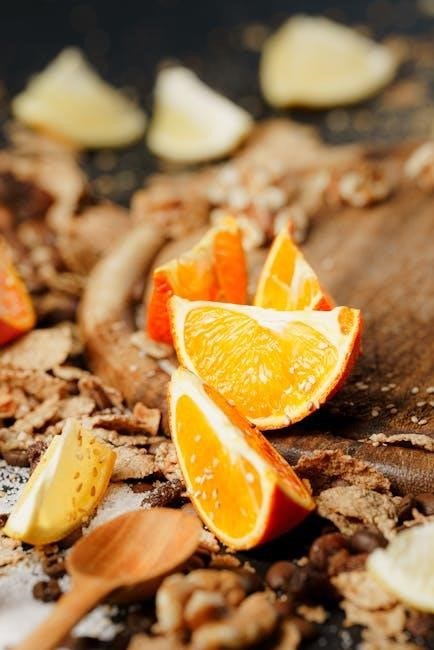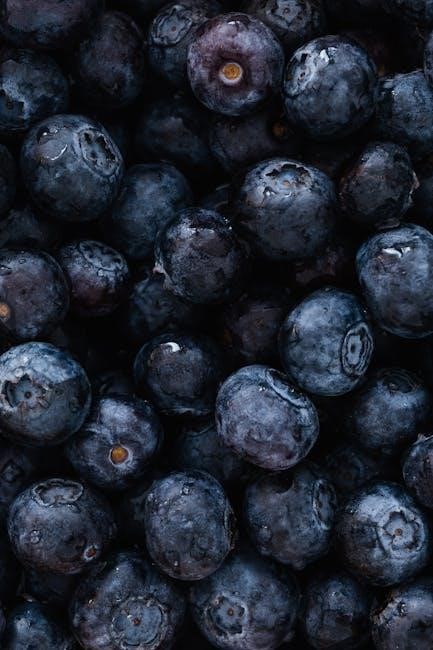A low residue diet focuses on reducing undigested food in the bowel, often prescribed for medical conditions or procedures. It limits high-fiber foods to ease digestion.
Definition and Purpose
A low residue diet, also known as a low-fiber diet, is designed to minimize the amount of undigested food that reaches the colon. This dietary approach focuses on reducing the intake of high-fiber foods, seeds, nuts, and raw or dried fruits, which can be difficult to digest. The primary purpose of this diet is to ease digestion, reduce bowel movements, and prevent discomfort or complications in individuals with certain gastrointestinal conditions or those preparing for medical procedures. By limiting fiber and residue, the diet helps reduce the risk of intestinal blockages and promotes healing in the digestive tract. It is often recommended for short-term use under medical supervision.
Benefits of a Low Residue Diet
A low residue diet offers several benefits, particularly for individuals with gastrointestinal conditions or those recovering from surgery. By reducing the intake of high-fiber foods, this diet minimizes the risk of intestinal blockages and alleviates symptoms of conditions like inflammatory bowel disease. It also helps reduce inflammation and promotes healing in the digestive tract. Additionally, a low residue diet can improve nutrient absorption by focusing on easily digestible foods. It is often recommended for short-term use to prepare for medical procedures or manage specific health issues. Overall, this dietary approach supports a smoother digestive process and enhances recovery in individuals with sensitive gastrointestinal systems.

Foods Allowed in a Low Residue Diet
A low residue diet permits foods like peeled, cooked vegetables, low-fiber fruits, and dairy products. It emphasizes easily digestible options to minimize digestive discomfort and promote healing.
Beverages
Beverages play a crucial role in a low residue diet by aiding hydration without adding fiber. Allowed options include decaffeinated coffee, tea, and carbonated beverages. Fruit juices, such as apple or grape juice, are permitted if they are free of pulp. Milk is also allowed but should be limited to two cups per day. Clear broths and herbal teas, like chamomile or peppermint, can be soothing and are generally well-tolerated. Avoid beverages with high fiber or additives that could irritate the digestive system. Staying hydrated is essential to support digestion and overall health, especially when following a low residue diet. Always choose fluids that are gentle on the stomach and align with dietary guidelines.
Low-Fiber Fruits
Low-fiber fruits are a great option for a low residue diet, as they are easy to digest and minimize undigested material in the bowel. Bananas, ripe melons, and avocados are excellent choices due to their soft textures and low fiber content. Fruits like apples and pears should be peeled and cooked to reduce their fiber content. Avoid raw or dried fruits, as well as those with seeds, skins, or pulp, as they can increase residue. Juices made from allowed fruits, such as apple or grape juice without pulp, are also permissible. Incorporating these fruits into your diet ensures you receive essential nutrients while adhering to the low residue guidelines. Always opt for ripe, tender varieties to enhance digestibility and comfort.

Cooked Vegetables
Cooked vegetables are a key component of a low residue diet, as they are easier to digest when properly prepared. Opt for well-cooked, tender options like carrots, green beans, and zucchini. Peel vegetables to reduce fiber content and cook them until soft. Avoid raw or undercooked vegetables, as they can be difficult to digest. Steaming, boiling, or roasting are ideal cooking methods. Mashing or pureeing vegetables further breaks down fibers, making them more suitable. Avoid high-fiber vegetables like broccoli, Brussels sprouts, and corn, as they can increase residue. Incorporating cooked vegetables ensures you maintain essential nutrients while adhering to the low residue guidelines. Always choose varieties that are soft and free of skins or seeds for optimal comfort and digestion.
Whole Grain Alternatives
Whole grain alternatives are essential in a low residue diet to reduce fiber intake while maintaining nutritional value. Opt for refined or low-fiber grains like white bread, pasta, and rice. Choose cereals made from refined flour, such as cornflakes or rice-based options, ensuring they are free from added seeds or nuts. These alternatives are easier to digest and help minimize undigested residue. Avoid whole grains like brown rice, quinoa, or barley, as they are high in fiber. Incorporating these low-fiber grains helps balance the diet without compromising on essential nutrients. Always check labels to ensure products are free from added seeds, nuts, or dried fruits, which can increase fiber content. This approach supports a gentle digestive process while providing necessary energy and nutrients.
Protein Sources

Protein sources are crucial in a low residue diet to ensure adequate nutrition. Opt for lean meats like chicken, turkey, or fish, and avoid fatty or processed varieties. Eggs are an excellent option, as they are low in fiber and easy to digest. Dairy products like low-fat milk, plain yogurt, or kefir are also suitable, provided they are free from added fibers or seeds. Tofu and legumes should be avoided due to their high fiber content. Ensure all protein sources are cooked thoroughly and served without skins or seeds. These choices help maintain a balanced diet while adhering to low residue guidelines. Always consult a dietitian to tailor protein intake to specific needs, especially if managing additional dietary restrictions like low phosphorus requirements.

Dairy Products
Dairy products play a significant role in a low residue diet, providing essential nutrients without adding fiber. Milk, both whole and low-fat, is allowed up to two cups daily. Plain yogurt and kefir are excellent choices, as they are smooth and easy to digest. Cheese, particularly low-fat varieties like cottage cheese or ricotta, is also permitted. Avoid flavored or high-fiber options. Ensure all dairy products are free from seeds, nuts, or fruit pieces. For those with lactose intolerance, lactose-free alternatives can be considered. Always opt for products with minimal processing and no added fibers. Dairy helps maintain calcium and protein intake, supporting overall health while adhering to the low residue diet. Consulting a nutritionist can help tailor dairy choices to individual needs, especially for those with additional dietary constraints.

Foods to Avoid in a Low Residue Diet
High-fiber foods like nuts, seeds, whole grains, and raw vegetables should be avoided. These can increase residue and worsen digestive discomfort, requiring careful elimination.
High-Fiber Foods
High-fiber foods, such as whole grains, legumes, and raw vegetables, are rich in undigested material that can exacerbate digestive issues. They should be avoided on a low residue diet to minimize discomfort and prevent complications; These foods include items like broccoli, Brussels sprouts, and whole-grain bread, which are difficult for the body to break down fully. By eliminating these from the diet, individuals can reduce the amount of undigested food reaching the colon, aiding in recovery and preventing blockages. It’s important to focus on low-fiber alternatives to maintain nutritional balance while adhering to dietary restrictions.
Raw or Dried Fruits
Raw or dried fruits are typically high in fiber and should be avoided on a low residue diet. These foods often contain seeds, skins, or pulp, which can be difficult to digest and may irritate the digestive system. Examples include berries with seeds, dried apricots, and raisins. Fresh fruits with tough skins, like apples or pears, should also be avoided unless peeled and cooked. Dried fruits, such as prunes or dates, are particularly high in fiber and can exacerbate digestive issues. Instead, opt for cooked or pureed fruits, which are easier to digest and lower in residue. Always check for added sugars in processed or canned fruit options.
Whole Grains and Cereals
Whole grains and cereals are high in fiber and should be avoided on a low residue diet. These foods contain bran, germ, and endosperm, which increase residue and can be hard to digest. Examples include whole wheat bread, brown rice, quinoa, and oats. Even whole grain cereals, like muesli or granola, are off-limits due to their high fiber content. Instead, opt for refined grains such as white bread, white rice, or pasta, which are lower in fiber and easier to digest. Always read labels to ensure cereals are free from added seeds, nuts, or dried fruits, which can increase residue. This helps reduce the risk of digestive discomfort and supports the dietary goals of a low residue plan.
Nuts and Seeds
Nuts and seeds are high in fiber and should be avoided on a low residue diet. They are difficult to digest and can cause irritation or blockages in the digestive tract. This includes almonds, walnuts, chia seeds, flaxseeds, and sunflower seeds. Even small amounts can contribute to residue buildup, so it’s best to eliminate them entirely. Be cautious of foods that may contain hidden nuts or seeds, such as baked goods, granola, or processed snacks. Always check ingredient labels to ensure these items are excluded. Removing nuts and seeds helps maintain a low residue intake, promoting smoother digestion and reducing the risk of complications. This is especially important for individuals with specific medical conditions requiring this dietary approach.
Processed Foods with Fiber
Processed foods containing added fiber should be avoided on a low residue diet. These include fiber-fortified cereals, granola bars, and breakfast cereals. Even seemingly harmless options like whole-grain crackers or bread can contribute to residue buildup. Always check labels for added fiber or whole grains. Foods like yogurt with chia seeds or fiber-enriched snacks are also off-limits. These products often contain indigestible fibers that can worsen digestive issues. Opt instead for refined or low-fiber alternatives, such as white bread or plain crackers. Avoiding processed foods with fiber helps minimize undigested material in the bowel, aligning with the diet’s goals to reduce irritation and prevent complications. This step is crucial for maintaining the effectiveness of the low residue diet.

Sample Low Residue Diet Menu
Breakfast: Scrambled eggs, white toast, and apple juice. Lunch: Baked chicken, mashed potatoes, and cooked carrots. Dinner: Fish, white rice, and green beans. Snack: Banana smoothie or vanilla pudding.
Breakfast Options
Start your day with scrambled eggs, white toast, or plain oatmeal. Yogurt with low-fiber fruits like bananas or applesauce is also a great choice. Smoothies made with peeled, low-fiber fruits and minimal ingredients are easy on the digestive system. Avoid whole grains, seeds, and nuts. Opt for decaffeinated coffee or herbal teas. Consider low-fiber options like cream of rice cereal or farina for a gentle start. Ensure all foods are well-cooked and tender to aid digestion. Incorporate lean proteins like turkey or chicken slices for added nutrition. Remember to stay hydrated with water or juices without pulp, such as apple or grape juice. Always check portion sizes and consult your dietitian for personalized recommendations.
Lunch Ideas
For lunch, consider lean proteins like grilled chicken, turkey, or fish, paired with low-fiber vegetables such as cooked carrots, green beans, or zucchini. White rice, pasta, or quinoa are excellent side options. Soups like vegetable broth with well-cooked, low-fiber vegetables are gentle on the digestive system. Sandwiches can include white bread with fillings like boiled eggs, cheese, or ham, avoiding seeds or whole grains. Salads with shredded lettuce, cucumbers, and peeled tomatoes, dressed lightly, are also suitable. Incorporate small portions of low-fiber fruits like bananas or applesauce for added nutrition. Ensure all foods are well-cooked and avoid raw or high-fiber ingredients. Stay hydrated with water, herbal tea, or pulp-free juices. Always prioritize low-fiber options and consult your dietitian for portion guidance.
Dinner Suggestions
Dinner options on a low residue diet should focus on lean proteins and well-cooked, low-fiber vegetables. Grilled or baked chicken, fish, or turkey are excellent choices. Pair these with sides like white rice, mashed potatoes, or pasta. Steamed or roasted vegetables such as carrots, zucchini, or green beans are ideal when cooked until tender. Avoid raw or high-fiber vegetables like broccoli or Brussels sprouts; Consider adding a small portion of low-fiber fruit, such as a banana or applesauce, for dessert. Beverages like water, herbal tea, or pulp-free juice complement the meal. Ensure all foods are thoroughly cooked and free of seeds or skins. Always check portion sizes and consult your dietitian for personalized guidance to maintain a balanced and gentle digestive routine.
Snacks and Desserts
For snacks and desserts on a low residue diet, opt for low-fiber, easy-to-digest options. Fresh bananas, applesauce, or canned fruit like pears or peaches are excellent choices. Plain, unflavored yogurt or kefir is also a great snack. For desserts, consider vanilla pudding, custard, or gelatin. Smooth, low-fiber desserts like sorbet or ice cream (without nuts or fruit pieces) are also suitable. Avoid any desserts with seeds, nuts, dried fruit, or whole grains. Beverages like water, herbal tea, or pulp-free juice can accompany snacks. Ensure all fruits are peeled and seeds are removed. Avoid adding high-fiber toppings or mix-ins. Always choose gentle, easily digestible options to maintain comfort and adhere to dietary guidelines. Consult your dietitian for personalized dessert ideas tailored to your needs.

Health Considerations
A low residue diet helps reduce undigested food in the bowel, preventing blockages and discomfort. It is often prescribed for medical conditions or pre-procedure preparation.
Importance of Chewing Food Well
Chewing food thoroughly is essential on a low residue diet. It breaks down food into smaller particles, reducing undigested material that could cause discomfort or blockages. Proper chewing ensures easier digestion, minimizing strain on the digestive system. For individuals with conditions like inflammatory bowel disease or those recovering from colorectal surgery, thorough chewing helps prevent complications. It also aids in nutrient absorption, promoting overall health. Rushing through meals can lead to swallowing larger pieces, which may irritate the bowel. Taking time to chew slowly and deliberately supports a smoother digestive process. This habit is crucial for maintaining comfort and ensuring the diet’s effectiveness in healing or preparing for medical procedures.
Hydration Tips
Staying hydrated is crucial while following a low residue diet. Drink plenty of fluids, such as water, clear broths, and juices without pulp. Aim for at least 8 cups (64 ounces) daily. Avoid carbonated beverages that may cause discomfort. Herbal teas and decaffeinated coffee are also safe options. Proper hydration helps soften stools, preventing constipation and promoting smooth digestion. It also aids in reducing the risk of blockages in the bowel. Avoid sugary drinks and limit caffeine intake, as they can dehydrate. Incorporate fluids between meals rather than during meals to avoid overwhelming the digestive system. Hydration supports overall gut health and ensures the diet’s effectiveness in managing symptoms or preparing for medical procedures.
Balanced Nutrition
Maintaining balanced nutrition on a low residue diet is essential to ensure proper bodily functions and overall health. Focus on including a variety of allowed foods, such as lean proteins, low-fiber fruits, and cooked vegetables, to provide essential nutrients. Dairy products and whole grain alternatives can contribute to calcium and vitamin intake. It’s important to avoid relying too heavily on processed foods, as they may lack vital nutrients. Consult a nutritionist to tailor your diet and ensure you’re meeting daily requirements. While the diet restricts fiber, it doesn’t mean sacrificing flavor or nutrition. Creative meal planning and supplementation, if necessary, can help maintain a well-rounded diet. Proper nutrition supports healing, energy levels, and long-term health goals while adhering to the low residue guidelines.

Lifestyle Tips for a Low Residue Diet
Plan meals in advance, gradually introduce new foods, and schedule regular health check-ups to ensure a smooth transition and maintain overall well-being while following the diet.
Meal Preparation
Plan meals ahead to ensure compliance with the low residue diet. Create a grocery list focusing on allowed foods like peeled fruits, cooked vegetables, and low-fiber staples. Cook meals in advance to save time and avoid last-minute decisions. Peel fruits and vegetables thoroughly, removing seeds and skins to reduce fiber content. Opt for lean proteins and low-fiber grains. Use herbs and spices for flavor instead of high-fiber additives. Consider consulting a nutritionist for personalized meal ideas. Keep meals simple and balanced, ensuring adequate nutrition while adhering to dietary restrictions. Proper meal preparation helps maintain consistency and makes following the diet more manageable.
When reintroducing foods after following a low residue diet, it’s important to do so gradually to avoid digestive discomfort. Start with small portions of low-fiber foods and monitor tolerance. Cooked and peeled fruits and vegetables are ideal, as raw or high-fiber options may cause irritation. Avoid sudden changes in your diet, as this can disrupt digestion. Stay hydrated to help your body adjust. Introduce foods one at a time and observe how your body reacts. If discomfort occurs, consult your healthcare provider for guidance. A slow and mindful approach ensures a smooth transition and minimizes the risk of complications. Always prioritize foods that are easy to digest during this phase.
Regular Health Check-Ups
Regular health check-ups are essential while following a low residue diet to monitor progress and ensure the diet is meeting your nutritional needs. Schedule appointments with your healthcare provider to assess digestion, weight, and overall well-being. These visits help identify any potential deficiencies or discomfort caused by the diet. Your doctor may recommend adjustments based on your body’s response. A dietician can also provide personalized guidance to optimize your meal plan. Regular check-ups ensure that the diet remains effective and safe, especially if it’s being followed for an extended period. This ongoing support helps maintain a balanced approach to your health and prevents potential complications. Consistent monitoring is key to achieving the best outcomes with a low residue diet.

Additional Resources
Downloadable PDF guides provide detailed meal plans and tips. Consulting a nutritionist ensures personalized advice, helping you manage your diet effectively and address specific needs.
Downloadable PDF Guides
Downloadable PDF guides offer comprehensive meal plans and detailed lists of allowed and avoided foods. These resources are designed to simplify meal preparation and ensure adherence to the low residue diet. Many guides include sample menus, shopping tips, and nutritional advice tailored for specific health conditions. They often cover topics like hydration, food preparation methods, and balanced nutrition. PDF guides are ideal for printing and referencing during grocery shopping or meal planning. They provide clear, structured information to help individuals manage their diet effectively. Consulting a healthcare provider before starting any new diet is always recommended to ensure it meets your personal health needs.
Consulting a Nutritionist
Consulting a nutritionist is highly recommended when following a low residue diet. They can provide personalized meal plans tailored to your health needs and ensure proper nutrition. A nutritionist can help you understand which foods to include or avoid, create balanced meals, and manage any underlying health conditions. They can also guide you on how to gradually introduce foods after a procedure or during recovery. With their expertise, you can avoid nutritional deficiencies and maintain a healthy diet. Many nutritionists offer downloadable resources, such as PDF guides, to help you stay on track. Regular consultations can also help monitor your progress and adjust your diet as needed for optimal results.